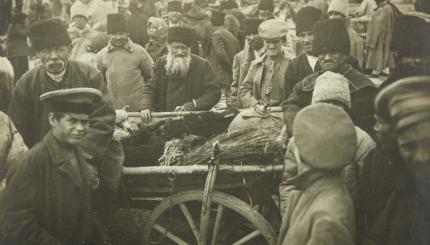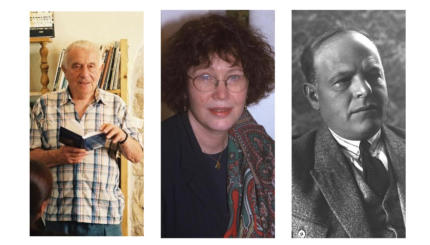As a doctor of philosophy, a rabbi, and a biblical commentator, Chaim Potok (1929-2002) had a lot to say. He would often wake at four or five in the morning, driven to wakefulness–because, he would say, of the sentences in his head. But foremost among his talents, Potok was a writer. Often his most profound thoughts and arguments would come not from his own mouth, but from the mouths of his fictional characters.

Over his lifetime, Potok authored eight novels, a number of short stories and novellas, and three children’s books. His most famous works included The Chosen, The Promise, My Name Is Asher Lev, Davita’s Harp, and I Am the Clay. He was also the author of a nonfiction book, Wanderings: Chaim Potok’s History of the Jews, and many works of Torah commentary.
Potok was born into an Orthodox family in New York, the eldest of four children. His parents were both immigrants from Poland whose life in Brooklyn was not so different from the Old World shtetl they had left behind.
After high school, Potok attended Yeshiva University. He earned his bachelor’s degree in English literature, going against the wishes of his family, who expected Chaim to become a teacher in a yeshiva.
Potok soon became disenchanted with the Orthodox world, finding Yeshiva University intellectually stifling. He went on to earn both his master’s degree and rabbinic ordination from the Jewish Theological Seminary, a Conservative institution, and subsequently served as the editor of Conservative Judaism magazine.
With your help, My Jewish Learning can provide endless opportunities for learning, connection and discovery.
In 1965, at the age of 36, he moved temporarily to Jerusalem with his family to write a dissertation for his doctorate in philosophy from the University of Pennsylvania. There, he dabbled in fiction, writing his thesis in the afternoons and a novel– about New York City–in the mornings. After he concluded his doctoral work, the Potoks returned to America, and Chaim began to seek a publisher for his just-completed book: The Chosen.
Chosen for Greatness
Published in 1967, it became a bestselling phenomenon, birthing a sequel (Potok’s next novel, The Promise), a major motion picture, and a deluge of critical praise.
The novel, set in the 1940s, tells the story of an unlikely friendship between two teenage boys–Reuven, who is Modern Orthodox and lives with his widowed father, and Danny, the son of a formidable Hasidic rebbe. It commences in the most unlikely way: During a baseball game between the Hasidic boys and the Modern Orthodox boys of the neighborhood, Danny accidentally injures Reuven’s eye, by hitting a fastball straight at him. Danny’s father sends him to visit Reuven in the hospital, and the two strike up a friendship.
Their friendship is helped along by both boys’ fractured family structures–Danny’s father only speaks to him during study periods; Reuven’s mother is dead and his father is an emotionally-distant academic. Though they discover the gap that divides their worlds, they also gain confidence in each other.
Danny trusts Reuven with his biggest secret: He has been reading secular books in the library, studying forbidden subjects like psychology and philosophy. In return, Reuven is welcomed into the cloistered Hasidic enclave. But when the State of Israel is founded, Reuven’s father becomes a vocal proponent of the fledgling state, and Danny’s father disapproves of Zionism. The two boys wrestle with their allegiances to their respective dynasties and to each other.
The Chosen depicts the split of Orthodox life between opposing elements–modern and yeshivish; Zionist and anti-Zionist–a factionalization which Potok witnessed firsthand during his time at Yeshiva University, and which may have led to Potok’s frustration, and ultimate rejection, of Orthodoxy.
The Burden of the Artist as a Young Man
In 1972, Potok’s third novel provided another look at the secluded Orthodox community. My Name is Asher Lev follows a Hasidic teenage boy with emotionally wounded parents; Asher’s father travels constantly, and his mother suffers anxious spells after her brother’s death. Asher is anti-social, and a talented painter. His art is the only thing that gives him solace.
Asher’s father is skeptical about his son’s talents, especially after finding nude studies of women and sketches of crucifixions in Asher’s possession. When they consult the Ladover Rebbe, the leader of their Hasidic sect, he is positive, even encouraging of Asher. The Rebbe pairs him with Jacob Kahn, a non-observant Jew who is sympathetic to their sect. Jacob hones the boy’s skills and gives Asher a sense that other possibilities exist for him–that he doesn’t have to be a Hasid forever. Though he contemplates breaking from religion, ultimately, he remains faithful to both his love of art and his love of God. At the book’s finale, Asher combines his artistic talent, his family anguish, and his Orthodox sensitivities by painting the masterpieces of his career: Brooklyn Crucifixion I and Brooklyn Crucifixion II, representing both his mother’s struggle and his own.
Like The Chosen, Asher Lev is a work of fiction, though both feature actual historical events and characters that are amalgamations of real people. According to Potok, the painter Jacques Lipchitz was a model for Asher Lev. The character is said to also include elements of Hendel Lieberman, a Lubavitch Hasidic painter who was an acquaintance of Potok.
The book inspired a sequel, written 18 years later, called The Gift of Asher Lev. It finds a much-older Asher living in rural France–still observant, but separate from his community. In the novel, he is summoned back to New York after a family emergency and becomes embroiled in the search for the next heir to the Ladover Hasidic dynasty.
More than Just a Jewish Writer
Though his books can be considered their own subgenre of Jewish fiction, Potok was reluctant to stay within his boundaries. I Am the Clay (1992) tells the story of a Korean family that adopts an orphan to replace their dead child. Davita’s Harp (1985) is historical fiction about intermarriage, religious devotion, and Communism in 1930s New York, and, unlike all of Potok’s other novels, features a woman as its central protagonist. Though successful and critically praised, these later books failed to have the widespread appeal and staying power of Potok’s earlier novels.
Potok was also a painter, producing Chagall-like portraits of dreamlike Jewish ritual scenes and animals. This, too, never quite reached the mass audience of his Jewish fiction. Potok’s painting career somewhat paralleled the journey of Asher Lev: a young man, very creative and very religious, who didn’t fit with his community. “I began to paint when I was about nine or ten years old,” Potok once said in an interview. “It really became a problem in my family, especially with my father, who detested it.” Potok even painted a Brooklyn Crucifixion of his own, resembling the painting in his novel.
As an academic and a rabbi, Potok was also deeply involved in textual commentary and interpretation. In 1965, he was appointed Editor-in-Chief of the Jewish Publication Society. Though he resigned from that position in 1974, he served in a freelance capacity as “Special Projects Editor,” encouraging and editing projects–among them the pshat commentary for the popular Rabbinical Assembly Torah commentary, Etz Hayim.
Potok struggled with religious Judaism, but also remained committed to it, and left behind a legacy of Torah commentary as great in scope and content as his fiction. He was not afraid to question tradition. But he also was not afraid, as he did in his Torah commentary and his non-fiction, to embrace it.
Hasid
Pronounced: KHAH-seed, Origin: Hebrew, a Hasidic Jew, a follower of Hasidic Judaism, a stream within ultra-Orthodox Judaism that grew out of an 18th-century mystical revival.
Hasidic
Pronounced: khah-SID-ik, Origin: Hebrew, a stream within ultra-Orthodox Judaism that grew out of an 18th-century mystical revival movement.
shtetl
Pronounced: shTETTull, Origin: Yiddish, a small town or village with a large Jewish population existing in Eastern or Central Europe in the 19th and early-to-mid 20th century.
Torah
Pronunced: TORE-uh, Origin: Hebrew, the Five Books of Moses.


